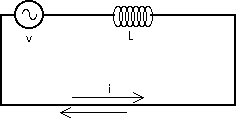



The figure shows the AC voltage and the current for this simple circuit. As you can see from the graph ithe current and voltage do not reach their maxima at the same time -- they are not in phase. The voltage reaches its maximum (or minimum) before the current reaches its maximum (or minimum); we describe this by saying "the current through an inductor lags the voltage across the inductor."
The rms voltage and current are directly proportional so we can write
VL = I XL where VL is the AC voltage across the inductor, I is the AC current, and the constant of proportionality XL is known as the inductive reactance and depends very strongly on the frequency,
XL = 2 f L
Why does a coil of wire reduce the current at all? As current flows through the coil a magnetic field is created and energy is stored in that field. When the current decreases that magnetic field collapses to zero and the energy stored in the magnetic field is put back into the circuit. As the current increases in the opposite direction a magnetic field is created in the opposite direction with energy stored in it. Low frequencies provide time to establish or reduce these magnetic fields while high frequencies are constantly changing the fields. The back emf provided by an inductor depends upon the rate of change of the magnetic field. Low frequencies mean little reactance and large currents while high frequencies mean large reactance and small currents. This is just the opposite of what we encountered with capacitors. The magnetic field B is proportional to the inductance L so we should expect the reactance XL to be proportional to L as it is.
XL = 2 f L
(c) Doug Davis, 2002; all rights reserved


Return to ToC